Jacob Davis
Designers Jason Ferro and Jason Briggs launch a menswear brand celebrating the inventor of the riveted jean

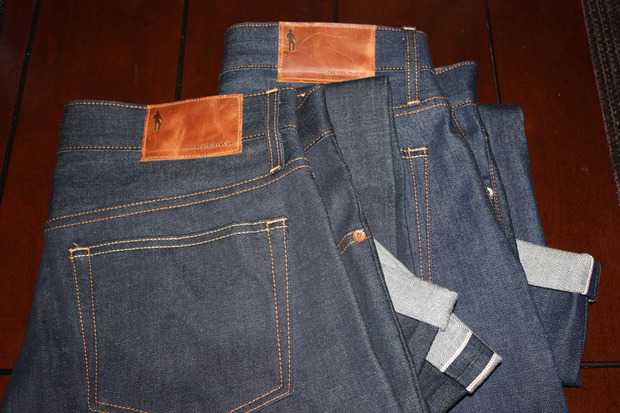
Born in Riga, Latvia in 1831, Jacob Youphes changed his name to Jacob Davis when he moved to the US in 1854. After series of his businesses failed, Davis, a tailor, reverted to his original skills to make ends meet. A prophetic meeting with a customer inspired the creation of the first pair of copper riveted jeans and, eventually, a long career with Levi’s. Celebrating the legacy of the denim pioneer, aficionados and designers Jason Ferro and Jason “Brigzey” Briggs are set to release a new line harkening back to Davis’ venerable tenure.
For more than 15 years, Ferro and Briggs have designed for Levi’s, Gap, Abercrombie & Fitch, Guess, Converse and nearly every major surf brand. Their previous line, Bread, focused on heritage styling. Now, in a beach bungalow in Marina Del Ray, California, the pair have been creating new pieces from selvage denim, twill, leather and more for the Jacob Davis collection. We caught up with them in their studio to learn more about their fascination with the history of denim and the story behind their newest “dream” collection.
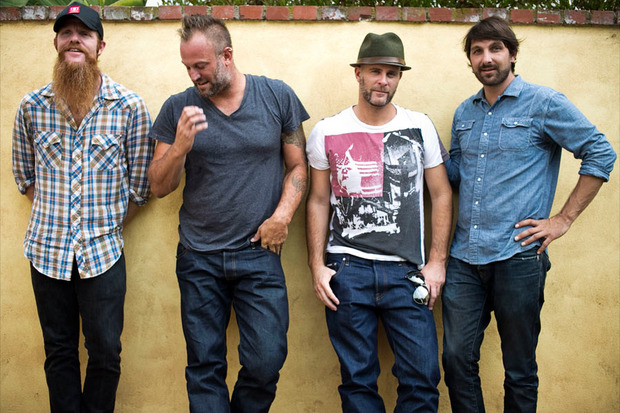
Where did the idea for your Jacob Davis line come from?
Ferro: When I was working at Levi’s, you hear the story and learn the history of Jacob Davis and Levi’s. We love his story. Basically we fell in love with the fact that he was an immigrant who came to the US from overseas as an entrepreneur.
Briggs: He’s like the unknown American icon. You ask nine out of 10 people if they know Levi’s and they say, “sure.” But you ask the same people if they know about Jacob Davis and they have no idea. He’s the guy who invented the rivet-reinforced pantaloon. He tried to patent it twice on his own when other people were knocking off his designs. He had been buying bolts of cloth from Levi Strauss. He wrote a letter to Levi’s saying, “I owe you this money for these bolts of cloth and I have a business proposal for you. Would you like to co-patent this rivet, I have sold 200 pairs of jeans in the last year.” They filed the application together in 1873. Then Davis moved his family from Reno to San Francisco. There, Jacob Davis set up his production sewing line and ran the factory for 39 years until his death in 1909. That’s an amazing story, and no one knows it. His name should be as synonymous with jeans as Levi Strauss.
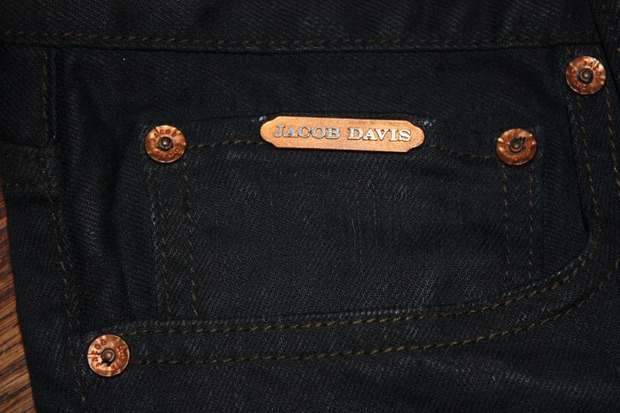
How is that you learned about all of this at Levi’s yet you ended up being the one to trademark it?
Ferro: We just wanted to tell the story of Jacob Davis and we thought, someone’s must already own this. It’s got to be trademarked. Someone must be doing this already. But then we checked and it wasn’t.
Briggs: We went over everything with our patent and trademark attorneys. We reviewed it and decided it made sense for us to go ahead and develop the collection. It goes with what we’ve been doing for years. It really made sense that we wanted to tell this guy’s story. It’s not just clothing. This is a lifestyle brand.
How do you approach the design to reflect both traditional and modern day denim styling?
Ferro: We start with the basic, the selvage jean. That goes back to the core of what Jacob Davis invented. Jacob Davis was also a tailor who made suiting. We make sure we always have that tailored aspect to the clothing and will also be making suits. For the denim, the fine details are very important to us—everything from the hardware to the rivets. It has to have that rooted, tailored Americana vibe to it. We like to dress in heritage, but we also need it to update is to make it cool and wearable. Fit, fabric and finish are important to us.

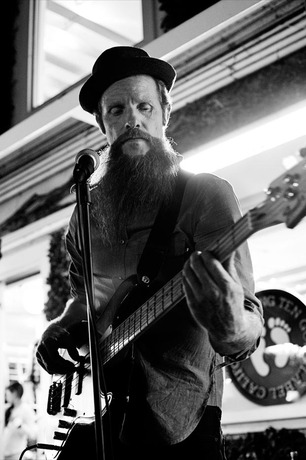
What is one of your favorite pieces in the collection that you feel embodies what it is about?
Briggs: We found some amazing Japanese twill selvage. We think the five-pocket twill will be a signature piece for us. We are going to do an array of colors.
Ferro: I agree the twill and canvas. That goes before the denim. It was the first thing that Jacob Davis started working with back in the late 1800s. What I am excited about is taking that and making it more modern. We also do a crop jean in selvage twill. We make a skinny selvage jean out of canvas and denim, made with all traditional fabrications.
When you are not designing where would we find you?
Ferro: In the studio, or playing the House of Blues. Our band Whitley Heights just released a record. We’ve been busy writing new music and playing shows everywhere we can.
Briggs: And having fun doing it. There are two other principal songwriters in the band. Mike DiPirro and Michael Faiella. Our buddy James Foster is the drummer.

How does the clothing line influence the music and the music the clothes?
Ferro: It goes back to the tradition and history of Jacob Davis and the tradition of instrumentation from banjo and mandolin, to standup bass and the drums. The feel of the music also represents that timeless aspect that the clothing represents. We are taking that heritage lifestyle in music and fashion and making it for today, for people who listen to music anywhere from Arcade Fire to Mumford to ’90s hair bands. The clothing and the music feed off of each other.
What are your goals with the brand?
Briggs: We’d eventually like to have our own retail store. Ultimately a Jacob Davis store will be a men’s store where you can walk in and get dressed seven days a week, including made to measure suits and tuxedos. That’s the whole concept of Jacob Davis. We’ll make luggage, sunglasses, shoes, and if you need board shorts for a trip to St. Barths. We will also have licensing concepts. We like the idea of Jacob Davis being this unknown American icon, who was an entrepreneur. When he moved to the west coast he was a tailor, but for three month he also owned a business selling cigars. At one point he put all of his money into a bar in Reno and lost his whole investment and went back to being a tailor. So we’d like to bottle a Jacob Davis whiskey.
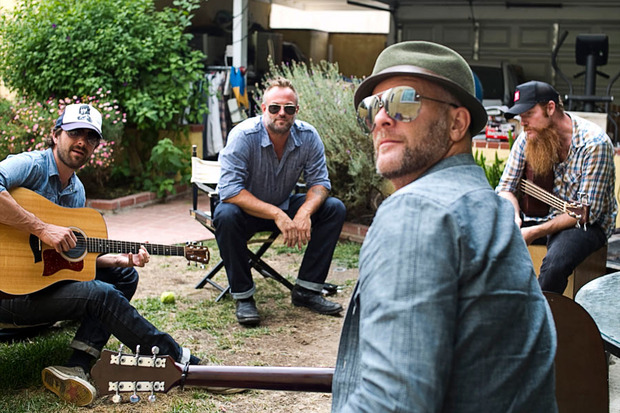
How does living in Los Angeles influence your designs and music?
Ferro: Everything from how LA is growing to how the artist district is growing. It’s a renaissance period again.
Briggs: We are both California kids, so just getting out in the surf, going to the beach. It’s amazing what just going to the beach and breathing in some of that ionized air can do for you for your soul. It’s incredible.
Ferro: The other thing about Jacob Davis, the lifestyle. If the music calls and we’re playing and inspiration comes, we are playing music that day. We need to be creative 24/7. We have to be creative no matter what it is we are doing. That will make the collection that much better. We don’t want anything to get stale.
Briggs: We like the saying, “Work hard, play harder.” For us we live it and breathe it—there is no off switch.
Why was the copper rivet so important?
Briggs: As the story goes, Jacob Davis had been making pants, horse covers and horse blankets. When you put a horse blanket over the horse, there is a pocket, which is the same shape at the back pocket of a jean. They would reinforce the pockets with rivets to hold heavy tools, nails, clamps and a hammer for re-shoeing the horse. This lady came into Jacob Davis and said, “My husband keeps ripping his jeans. What can you do? I am tired of mending his jeans.” He was apparently a rather large man. Davis thought about it and thought maybe he could rivet the stress points, the fly, and the back pockets. From there it just caught on. It was more out of function that as a design aesthetic.
Ferro: And the rest is history.
Jacob Davis will be available at Bloomingdale’s and in select retailers soon. For now, you can keep up with the brand through their Facebook page.












